Keck School of Medicine of USC students and faculty gathered to learn more about genetic cancer therapy and neurotransmitter release in the brain at the 2014 Lasker Lectures Program, held on March 4 at Mayer Auditorium.
Richard H. Scheller, PhD, executive vice president, research and early development at Genentech, and Thomas C. Südhof, MD, Avram Goldstein Professor and professor of molecular and cellular physiology at Stanford University School of Medicine, were co-winners of the 2013 Albert Lasker Basic Medical Research Award for their work over the course of two decades on the mechanisms that underlie neurotransmitter release.
The Lasker Foundation’s mission is to foster the prevention and treatment of disease and disabilities by honoring excellence in basic and clinical science, educating the public and advocating for support of medical research. Its awards program recognizes contributions of those who have made major advances in the understanding, diagnosis, treatment, cure or prevention of human disease.
“We’re here today for a celebration of science,” said Keck School Dean Carmen A. Puliafito, MD, MBA, who welcomed attendees. “This is the first time in the history of the Albert and Mary Lasker Foundation that an academic medical center has hosted both the Albert Lasker Basic Medical Research and Clinical Award recipients.” (The clinical award recipients will speak at the Health Sciences Campus on April 10.)
Increasing awareness of research translation is vital in today’s funding climate, added Clair Pomeroy, MD, MBA, president of the Albert and Mary Lasker Foundation, during her welcoming remarks.
“The NIH budget has flatlined for the last 10 years, resulting in a 25 percent loss in purchasing power,” she said. “We’re thrilled that the Lasker Foundation and Keck School of Medicine are collaborating on this very special event.”
Scheller’s lecture, “The War on Cancer 2014,” focused on gene mutations that have been found to initiate or increase tumor growth, and the promising regulators and inhibitors that are being tested to impede that growth.
For example, according to Scheller, 40 to 60 percent of melanoma patients have a BRAF V600 gene mutation; BRAF mutations stimulate cell growth. Scheller cited research showing that the drug vemurafenib inhibits tumor growth. “We also found that adding a Mek inhibitor [chemicals or drugs that inhibit certain enzymes along signaling pathways] partway through treatment increased the duration of tumor inhibition by two to three times,” he said.
Scheller also described some gene mutations in metastatic disease that are extremely difficult to treat. “In the genomic landscape of somatic mutations in a lung tumor, we found that there were over 50,000 point mutations and over 20 major genome rearrangements,” Scheller said. “We wondered, why doesn’t the immune system recognize these cells as mutant and attack them? The answer is that although T cells are programmed to find tumors, the tumor itself turns off the T cell’s response. We’ve only recently begun to understand the mechanisms whereby this takes place.”
Scheller described research that targets these tumors with the protein Anti-PD-L1, which inhibits tumor response so that the T cells can perform their functions.
Südhof’s lecture, “The Mechanism of Neurotransmitter Release,” focused on the basic mechanisms that he and his team discovered about how neurotransmitter release between synapses happens that resulted in his Lasker Award. (Südhof also received the 2013 Nobel Prize in Physiology or Medicine for discoveries of machinery regulating vesicle traffic.)
Neurotransmitters are chemicals that transmit signals across a synapse between neurons. “Twenty-five years ago, not a single synapse component had been molecularly described,” said Südhof. “Today we understand the structure and know how the machinery works. This is work at a very fundamental level of biology.”
Synapses are the fundamental computational units of the brain, Südhof explained, and although synapses differ in properties, all synapses operate by the same principle: An action potential invades the presynaptic nerve terminal, an influx of presynaptic calcium ions triggers neurotransmitter release, and then those neurotransmitters bind to postsynaptic receptors and provoke an electrical signal.
Synaptic transmission happens extremely quickly, said Südhof. “Three processes enable this speed: synaptic vesicle fusion, the triggering of that fusion through calcium and the fact that the calcium influx is localized right next to vesicles that are ready to fuse — any distance between the calcium channel and the vesicle release sites would result in neurotransmitter release blockage.”
— By Amy E. Hamaker


